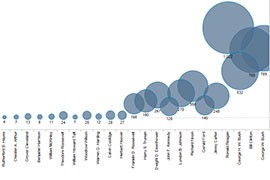Cronkite News has moved to a new home at cronkitenews.azpbs.org. Use this site to search archives from 2011 to May 2015. You can search the new site for current stories.
Proclamation explosion: Despite glut of ‘official’ days, groups like honor
WASHINGTON – As executive director of the Arizona Developmental Disabilities Planning Council, Larry Clausen is thrilled that President Barack Obama declared October National Disabilities Employment Awareness Month.
So thrilled, that he doesn’t mind sharing the calendar with National Energy Month. Or with the arts and humanities, cybersecurity, breast cancer, substance abuse prevention, domestic violence or other ceremonial causes among the 15 proclamations – as of Friday – that Obama has signed for October.
But Obama is just following the trend of other Proclaimers-in-Chief, who began issuing ceremonial proclamations in earnest at the beginning of the 20th century and peaked with 532 such citations in one term by former President George Bush.
“There are a lot of issues that need attention,” said Jessye Johnson, deputy director of the Arizona Coalition Against Domestic Abuse, another group that has October as “its” month.
For groups like Clausen’s and Johnson’s, a presidential proclamation can bring attention to the cause and credibility to the organization, said Brandon Rottinghaus, an associate professor of political science at the University of Houston.
“There is a vast majority that simply never get national attention, but proclamations are very useful for these groups,” Rottinghaus said. “They want to create more interest in their cause.”
Rottinghaus, with fellow professor Jeremy Bailey, has created an online database that lists all presidential proclamations, from George Washington to George W. Bush. Obama has not yet been added.
Ceremonial proclamations are just a fraction of the database – and a fraction of what presidents use proclamations for.
They are often more serious than the observance of the month. Abraham Lincoln used the Emancipation Proclamation to free slaves, for example, while Gerald Ford pre-emptively pardoned his predecessor, Richard Nixon. Harry Truman pardoned 1,062 World War II draft dodgers and Jimmy Carter pardoned Vietnam draft dodgers in presidential proclamations.
For a number of presidents, their first ceremonial proclamation is the announcement of their predecessor’s death and a call for a national period of mourning.
They can be used to declare a park on public lands. Just this month, for example, Obama proclaimed “Establishment of Cesar Chavez National Monument” on property in Keene, Calif.
Randy Sowell, archivist at the Harry S. Truman Library and Museum, said proclamations are typically holidays and special events and are used by presidents to “issue a statement to the public at large.”
“It is directed to people outside the government, to observe a particular event,” Sowell said.
That is distinct from the other presidential document, the executive order. While proclamations are generally directed to the people, Rottinghaus said, orders are aimed at the government.
Proclamations can be requested by Congress or issued by the president, sometimes to mark an occasion but often to advance an agenda. Rottinghaus cited Obama’s call for National Equal Pay Day on April 17, 2010, before an equal-pay bill went to the Senate.
“They can use the ceremony aspect of the proclamation to engender an atmosphere of support for the issue,” Rottinghaus said.
Groups that are recognized by presidential proclamation “don’t get anything tangible out of it, but it’s the highest kind of recognition to them.”
That’s true no matter how crowded the calendar, advocates said.
“It doesn’t make any difference,” said Clausen, who said his group “can get the message out just as effectively” whether alone or sharing the spotlight with others.
Clausen called the presidential attention “fantastic,” saying it “reinforces the concept that work is an integral part of everyone’s lives.”
The Arizona Developmental Disabilities Planning Council will participate in a job fair in Phoenix this month, is producing videos to educate employers about what is involved when they hire disabled staff, and is advocating for equal pay.
“We think this month is a catalyst in terms of job programs we are developing,” Clausen said. “We are getting the word out to communities and employers.”
Johnson said her group works year-round, but having October dedicated to the cause through a presidential proclamation gets a wider audience.
“It sort of raises the visibility and gives a platform that some causes wouldn’t have on a day-to-day basis,” she said.
Another advocate said it’s not about stealing attention from another group.
“It’s not about competition, it’s about awareness,” said Jack Rodgers, a spokesman for River Source, a Mesa drug and alcohol treatment center.
“There are only 12 months with so many issues,” Rodgers said. “There aren’t enough months to go around for everyone.”
The River Source is not doing anything out of the ordinary for substance-abuse prevention month, because “everything we do every day is special,” Rodgers said.
“A specific month is not going to make that big a difference,” he said.
But the Arizona Coalition Against Domestic Abuse sponsors a “wear purple day” in October, another attempt to draw attention, Johnson said. October is a “time for us to support community events that are related to domestic violence awareness month,” she said.
Rodgers conceded that seeing a group of people wearing purple might peak his curiosity and cause him to ask, “Hey, why are you wearing purple?” If it brings attention to the cause, whether it’s a purple shirt or a proclamation, he’s for it.
“From an industry perspective, anything and everything that can be done to raise awareness is a great thing,” Rodgers said.








